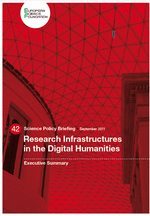The ESF Standing Committee for the Humanities (HUM (formerly SCH)) identified the topic of Research Infrastructures (RIs) as an area of strategic priority for the humanities in 2009. An HUM (formerly SCH) expert group on RIs was set up the same year and mandated to propose a proactive strategy for RIs in the humanities at the European level on behalf of HUM (formerly SCH). In the past few years the group, together with the support of the ESF office, has been active both at the policy and research levels.
Appropriate liaisons with the ESF Member Organisation forum on RIs as well as the Mapping of the European Research Infrastructure Landscape (MERIL) project were established. Furthermore, a workshop on Research Communities and Research Infrastructures in the Humanities was organised in 2010 to gather different research communities’ perspectives on the scholarly-driven design and use of RIs in the humanities.
In addition, a Science Policy Briefing (SPB) on “Research Infrastructures in the Digital Humanities” was written at the invitation of the ESF HUM (formerly SCH) and was published in September 2011.
The publication – produced under the editorial chairmanship of Professor Claudine Moulin (ESF HUM (formerly SCH) member (LU)/Trier Center for Digital Humanities, Universität Trier) - reflects on the centrality of RIs to the humanities. It argues that without RIs such as archives, libraries, academies, museums and galleries (and the sources that they identify, order, preserve and make accessible) swathes of humanities research would not be possible. After proposing a wide-ranging definition of digital RIs in the humanities, it attempts to relate physical RIs to digital ones. By drawing on a number of case studies it demonstrates that digital RIs offer humanities scholars new and productive ways to explore old questions and develop new ones. Indeed, it is argued that the making available of our cultural heritage in digital form and the sensitive interlinking of such resources opens a new frontier for humanities research that calls on us to address ‘grand challenges’ in the humanities and beyond. These include not only research-based challenges, such as data-driven humanities, but also institutional and social issues, such as the provision of higher education programmes as well as the recognition of the inherently process character of digital research and the implications of this for evaluation and promotion.
While numerous sophisticated RIs that can inform and further humanities RIs already exist in the sciences, ultimately it is also necessary for humanities scholars to build and have access to ‘fit for purpose’ humanities RIs, given the nature of their data-sets, research methods and working practices. Indeed, a fundamental difference between data-bases as they are used in the humanities and those that are used in other sciences is that the creation of digital objects is more than just preparation for research, it is rather a crucial part of humanities research itself. The way in which inscriptions are photographed or in which text corpora are transcribed and encoded, is crucial for the way in which these research objects will be studied in the future.
This ESF SPB attempts to tackle the need to identify priorities and future research directions for a common strategy on RIs in the humanities at the European level. Furthermore, despite the recent (and therefore often uncoordinated) surge of activities in the digital humanities, it provides a unique overview, analysis and set of research policy recommendations related to digital humanities in Europe never attempted before. Its target audience encompasses the research community at large (within the wide umbrella of the humanities but including also Computer, Library and Information Sciences engaged with humanities research and some branches of social sciences or e-social sciences), academic and non-academic institutional bodies and national and international policy makers.





